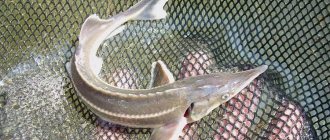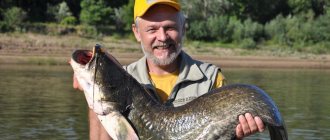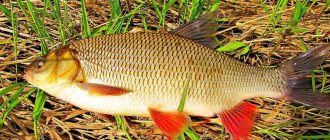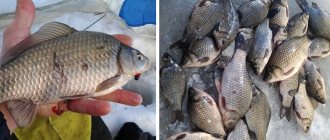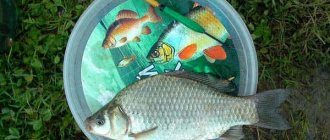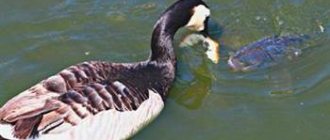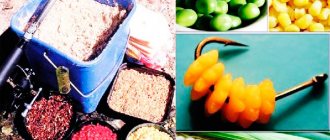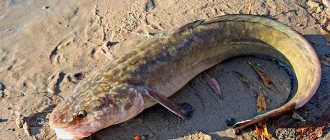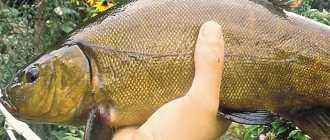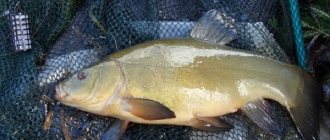The article talks about catching tench with a float rod. Important aspects of fishing related to fishing tactics, site preparation, selection of optimal baits are covered, and some dogmas regarding tench fishing are also debunked.
Two seasoned bears do not live in the same den - experienced floaters do not copy each other's fishing, everyone has established views, and a strong push for change is needed.
For me, the reason to change something in my fishing was the example of my friend, an experienced tench fisherman, who last season staged a real “massacre” of large tench on lakes and oxbow lakes. At the same time, he was not greedy; he could have caught much more if he had gone out more often. From July to October I picked up fish weighing from 1 to 2.5 kg; mixed with tench, respectable crucian carp weighing up to 1.5 kg periodically flew in. My friend is clearly focused on hunting for large fish, but I belong to the float “clan” that practices a “sporting” approach - light equipment, compact baits, confident fishing with a fishing rod for small and medium whitefish. My element is fishing for quantity, when there are a lot of bites, it’s fun and interesting. Catching a big trophy is a pleasant surprise. Last year, a large tench weighing 1.4 kg unexpectedly landed on my hook while catching a rudd - I was lucky, the fish did not want to go into the roots of the water lilies, and I managed to get it on a thin leash. I sorted this matter out, taking a close look at the experience of my friend, and decided to engage in targeted tench fishing.
First tench fishing experience
On the first exploratory fishing trips, I usually set out three fishing rods. A fly rod seven and two distant rods - one throws a float at 15 meters, the second a little further, thereby covering three possible lines of lines along the shore. When the line trails were explored, I switched to fishing with two rods. An important question immediately arose - the choice of a specific place for fishing. Usually on linear reservoirs there is nothing to attach to; many areas of lakes and oxbow lakes are of the same type: the water area is overgrown with soft algae, the surface is covered with duckweed, the depths are small, about 1-2 m without any significant edges or drops. From the shore it may seem that the bottom of the reservoir is heavily silted, but in reality it often turns out to be quite hard, with only a slight coating of silt. I figured this out with my own feet - I climbed into the grass to clear the “battlefield.” Intuitively I chose two places at a distance of fifty meters from each other, one shallower, the second deeper, subsequently both points worked well. I cleared the places mainly with a special “cat”, reminiscent of a comb. The tool is a metal pipe 40 cm long. A hole is made in the center for tying a ten-meter piece of rope. Metal rods 5 cm long are welded to the pipe, which bristle in different directions. Five casts in one direction, and the place is cleared of algae. A dead end is a window for a float, a corridor leading to the shore - for the convenience of landing fish. Of course, the wind is slowly driving the duckweed away again, but the main thing is that there are no thick algae in the water column, and the duckweed can be broken through without any problems using massive equipment - a float with a carrying capacity of about 4 g. When the “cat” could not cope with thoroughly cleaning the area, he cleaned it with his hands, walking in a wading suit into the water up to his chest. During long breaks in fishing, the place was cleared before the next fishing, but this did not disperse the fish throughout the area - 20-30 minutes after cleaning, active tench biting began.
About careful tench biting and the moment of hooking
Here we will talk specifically about biting on a float rod. On the bottom, the tench usually hooks itself, but on the nodding tackle it bites briskly and confidently.
Many sources mention that the tench takes the bait extremely tediously and carefully, sometimes “stretching out the pleasure” for as much as a quarter of an hour. I will say this - this statement is not unfounded, although in practice everything is usually simpler and faster.
As I see it, the tench bite is in many ways reminiscent of the crucian bite. The float still begins to barely go deep or stick out of the water, moving from side to side. This can go on for a long time: the tench likes to fiddle with the bait with the tips of its lips, as if disdainful of grabbing it completely. The fisherman needs to be patient, because rush is completely inappropriate now. You should hook only when it is clearly visible from the float that the fish has finally “decided” - it will fall to one side, completely disappear under the water, or confidently move to the side.
Sometimes the reason why a tench takes too long to bite is because the bait has sunk in the mud . The fish begins to dig it out, and does it clumsily and for a long time. A small foam ball placed on the fishing line just above the hook, or on the hook itself, closer to the ring, will help keep the bait on the surface of viscous underwater soil.
Experiments with bait for tench
Experiments with bait showed that such classic line delicacies as cottage cheese, cut and whole worms did not bring the desired result. But a simple bait for tench, consisting of a mixture of lupine and raw corn, worked great. Equal proportions are soaked for a day and boiled a little. Sometimes I also added steamed wheat to these ingredients. At first I drove around for a day or two, exploring the place, not fishing. Then he stopped baiting and simply threw in the bait immediately before fishing. I experimented with the amount of feeding, adding different portions, sometimes more, sometimes less. Supplemented during the fishing process. On other fishing trips I made do with only the starter feed, throwing the remaining mixture into the water after the end of fishing. As a result, I never found the best tactical option. Perhaps tench would bite just as well without any bait at all - an artificial window among green thickets in itself attracts fish well, in the future this theory will need to be tested.
Bait for tench fishing
Bait is used to keep the fish in the chosen place longer. They begin to feed 1 week before fishing, observing the diet of the fish. Some prepare this mixture on their own, others purchase it in the store.
Experienced fishermen recommend purchasing supplements from Russian manufacturers, which take into account the conditions of Russian reservoirs. Considering that tench has a sensitive sense of smell, you should not take cheap products of dubious quality with an abundance of flavorings and a foreign mixture.
The bait consists of peas and sunflower cake, millet and oatmeal porridge. In addition, the mixture includes crushed worms and maggots with bloodworms. Tenches readily swim to the smell of cottage cheese mixed with peat or to white bread soaked in the water of this reservoir and mixed with soil.
Homemade bait recipe (made on the shore):
Soak 700 g of ground rye crackers, add a little earth, 70 g of oatmeal and the same amount of cake with sunflower seeds, fried and ground.
Appetizing balls:
Mix 1 part each of rye bread or cottage cheese, toasted and ground hemp seeds and rolled oats. Add 4 parts of soil to the prepared bait. Tench like the smell of coriander, cumin, hemp and cocoa in bait, and rarely, garlic. And rot and mold will scare away the fish.
To bait tench, you can use ready-made bait or make it yourself.
In what weather does tench bite?
As for suitable weather for tench fishing, the consistent catches have convinced me that with a good density of fish there is no such thing as “optimal tench weather”. Academically, it is considered to be drizzle when it is cloudy and windless. But fishing practice has shown that all this is complete nonsense! The tench bit well in cloudless weather and the scorching sun. Not only did the classic dawns work; during the day I caught just as many fish. I just tried to choose relatively windless days - the wind interferes with fishing purely technically, and if it is blowing, then let it be at your back.
How to catch tench with a float rod in the summer. Bait
Tench is not a predatory fish, but oddly enough it loves to feast on animal food. In old books on fishing they advise fishing with dragonfly larvae or molted crayfish, but getting these baits is problematic. Experienced fishermen advise turning to more accessible types of bait such as:
- Worm
- Maggot
- Bloodworm
- Pearl barley
- Corn
Article in Yandex Zen: How to prepare a worm so that the fish bite madly
Tench is found in places that are not convenient for the fisherman, tench requires a special fishing rod, it does not like abundant bait, especially when it is noisy, it does not “run” from all over the area to a special flavoring, as white fish do….
Tench is a heat-loving fish, common in the south and western regions, where the climate is milder. The best season for catching tench is summer, and the gear is a fishing rod. But in order to catch tench in the summer with a fishing rod, you need to take into account the peculiarities of its behavior, since typical methods are not entirely suitable here.
Tips for fisherman: Fishing for grayling on small rivers in summer video - Features of choice
Tench is found in places that are not convenient for the fisherman, tench requires a special fishing rod, it does not like abundant bait, especially when it is noisy, it does not “run” from all over the area to a special flavoring, as white fish do….
Where to find tench
A typical place for catching tench is a cartilaginous bottom completely covered with hornwort. If there are no such places in the reservoir, then you need to look for the bottom with a minimum of silt deposits (no more than 20 cm) in gaps, under a carpet of algae.
To search for tench, it is better to use a light inflatable boat, since the indicated concentration areas, spits overgrown with a carpet of vegetation, and bottom rises are often not accessible from the shore.
Often linear places are densely overgrown without gaps. In this case, you need to clear the bottom of algae. This can be done carefully with a small rake. Tench does not like to leave the thickets, so the window in the grass should be of minimal size.
How to feed a tench
Bait with balls is noisy and absolutely not suitable for catching tench. The bait should be thrown in crumbly form, or in separate granules. But you don’t need a lot of bait - usually 3-4 handfuls of high-calorie food are enough, so there shouldn’t be any problems with casting such a quantity if you operate from a boat. But you won’t be able to throw crumbly bait from the shore; you’ll have to go into the water. Or shoot with a slingshot with very small balls and individual grains.
All food is thrown into the chosen place at the beginning of fishing. Supplementary feeding is done quite a bit in the process, just to maintain the interest of the fish. And if there is no bite, or if it weakens, you need to look for a more favorable place.
Large tench stick to overgrown, but not swampy places
How to catch tench
To catch kilogram tench in the thickets you need strong equipment; with a thin “weir” you shouldn’t even count on success in the confrontation. It seems that the tench, which constantly collects food among the algae, is not so sensitive to the thickness of the fishing line and the weight of the hook. The number of bites does not increase when using thin tackle.
When to catch tench
The best season for catching tench is summer, when the aquatic thickets grow to their maximum. But during the day the activity of tench is far from the same. It's rare to catch this fish at midday. A dead night is also ineffective. But the time at dawn and in the morning before 8 o’clock is the best. You need to meet the dawn on a pond in a boat, fully armed. Therefore, as a rule, fishing for tench is successful only in explored places, when the approximate fishing location is determined, or at least the direction of movement is known.
The special attractiveness of this fishing lies in the fighting qualities of the fish. A large hooked tench makes a powerful jerk deeper into the grass, after which it is by no means easy to remove and catch this opponent in the landing net. During a short fishing trip, there are not many tench bites; you need to wait and take each one, because your opponent deserves it.
Tench, like other fish, is good for bait. He loves the smell of worms or maggots, so it is important that these components predominate in your bait mixture. You can also add boiled corn, but in small quantities. Throw bait in small quantities to attract fish and not overfeed them. Don’t forget to be careful with the tench, cast the mixture in advance. This is done so that the fish returns to the place after being startled by the splash. During this time, set up your gear.
Equipment for catching tench and landing it
Waiting for a large tench to bite is half the battle, because you still need to get it. Surrounded by dense “greenery”, the fish have a lot of chances for success, and the cleared corridors leading to the shore did not give much - the tench stubbornly did not want to follow it, often went to the side, and without any problems tore leads of 0.14-0.16 mm. I had to switch to stronger 0.20 mm leads, but even this diameter did not always help, but 0.22 mm solved the problem. Here the question may arise: why not initially fish with strong fishing lines? Yes, experienced molters can easily pick out excellent fish on a 0.30 mm fishing line. But this is when there is gluttony. And so usually tench are very careful and suspicious, do not tolerate rough equipment, which gave rise to the dogma that this fish bites rarely, in separate short periods. In reality, tench is excellently caught from early spring until the second half of October.
What is the best way to catch tench?
In June, in order to get the desired trophy, you should catch tench using live food. It is better to use larvae:
We also recommend reading:
Roach in June 2021: rules and features of fishing Fishing for crucian carp in June 2021: an unpredictable activity Catching perch in June 2021: an exciting and challenging activity Catching bream in June 2021: rules, tips, nuances
- mosquito;
- caddisfly;
- stoneflies.
You can fish with a leech or combine plant and animal baits. At the end of June, the fish bite will subside, so you will have to constantly experiment with complementary foods and baits.
If we talk about fishing with a worm, it is recommended to take a red worm without foreign odors. On small lakes and rivers, fishing is done using caddis flies as bait. If you use bait in these places in the form of barley, maggots, bloodworms, there will be no bites. When trying to catch large specimens, it is worth using pickled corn as bait.
My signature move!
Next season I plan to continue to develop this topic, because tench fishing is such an exciting activity. But using a slightly different strategy. I won’t get into the thicket of algae - on the reservoir you can find suitable clean areas near the sparse pitcher plant. If somewhere needs a little cleaning, I’ll do it, a reliable “cat” is always with me. I will only fish short with a 7 m fly rod. And I will start with the usual gram equipment, a 0.15 mm leader, with a 0.18 mm main line. I will do everything to ensure that line bites take place. If I can’t hold the fish, I’ll strengthen the equipment a little bit. And I will continue to use my signature technique, which works well both on tench and on other white fish - from time to time I sharply, but very briefly, jerk the rod upward towards myself. At the same time, the bait moves only a little towards the shore, at the same time rises slightly upward, then slowly floats downwards - it is at this moment that greedy bites often occur.
Description and catching of dace
Feeder fishing strategy
Pike on a spoon
Choosing a place to catch tench
On the territory of Russia, in the Asian part, it is less common than on the other side of the Urals. For Baikal and Eastern Siberia, tench is a rare catch. Tench prefers to live in reed and water lily thickets, among reeds and sedges, no deeper than 1.5 m and no shallower than 50 cm. The bottom is muddy, but the mud is no thicker than half a meter.
Tench are often found on a hard bottom with a thin layer of silt, overgrown with horsetail, or in creeks that are flooded in the spring. As the water warms up, it grazes at a meter depth, along the edge of vegetation and where there is a weak current. It often lives in the beds of oxbow lakes and in the stagnant water of small ponds and lakes among pondweed, egg capsules, and uruti.
It does not like rapids and cold water with springs, but can be caught in cool and windy weather. Tench prefers to live alone and calmly in a familiar place, grazing in water windows (fishermen do it themselves with a rake).
catching tench among thickets of common arrowhead, among Elodea canadensis and hornwort. But if Golden and Silver crucian carp, carp, roach, ide and bream were seen in the reservoir, then tench also lives here.
To catch tench, you should choose places with thickets of reeds and water lilies.
Preparing the bait
Tench, like other fish, is good for bait. He loves the smell of worms or maggots, so it is important that these components predominate in your bait mixture. You can also add boiled corn, but in small quantities. Throw bait in small quantities to attract fish and not overfeed them. Don’t forget to be careful with the tench, cast the mixture in advance. This is done so that the fish returns to the place after being startled by the splash. During this time, set up your gear.
When using running-type equipment, you need to use an assembly with a reel, where a small supply of fishing line is taken. With this option, you can cast over the longest distances. In addition, fishing for tench is much easier.
This fish can only be found in fresh water. Catching this fish is not as easy as it seems, and the best tackle for this is considered to be a float. How to use this rod correctly? Let's consider this issue.
Tips for fisherman: Do-it-yourself hook for a bottom fishing rod, drawings - Features of choice
The tench is very different in its head structure and the large amount of mucus on its body. The color of the fish changes quite often, it depends on where the tench is located. It is advisable to go fishing in places where there is warm water and a large amount of algae, for example:
- Lake.
- Backwater.
- Pond.
- Bid.
The weight of the fish often exceeds 2.5 kilograms, for this reason the tench is quite difficult to pull out when biting. Catching this fish is quite easy if you use a float. As a rule, bites begin at the moment when the equipment sinks to the bottom; the cast should be repeated only when the bait lies on the muddy bottom.
You can get the rest of the secrets of successful fishing for free by reading our other articles on the site.
Tench obviously exhibit seasonal feeding. Thanks to a certain systematization, anglers were able to find out at what time and what tench reacts best to:
Unfortunately, tench have a very unpleasant character trait for fishermen - caution and excessive timidity. Therefore, you need to catch this fish exclusively in complete silence, far from noisy companies. Plus, every movement of the fisherman should be carried out smoothly, and clothes should be chosen that are comfortable and do not rustle when moving. After casting the bait you will have to wait a long period of time.
Have you really traded your favorite bottom fishing for float fishing
? During the warm period of this year, I undoubtedly changed it! How could it be otherwise, when such an excellent and not often caught fish like tench simply haunted my gear?!
Have you really traded your favorite bottom fishing for float fishing
? During the warm period of this year, I undoubtedly changed it! How could it be otherwise, when such an excellent and not often caught fish like tench simply haunted my gear?!
I loved the evening silence of solitude when catching this fish even more for its versatility, grace, diversity and special simplicity. For the first two months of summer, the “Chekhov’s” burbot for me was tench, that is, the fish that was in the foreground.
Fishing practice and observations on this occasion destroy my existing opinion about tench and go in a completely different direction than the recommendations from many books and magazines about catching this beautiful fish. I want to share everything I experienced during this time. You should not think that tench is a super cunning and capricious fish, it is rather a test of the skill and essence of the floater. The first sign of determining whether there is a tench in the selected reservoir is simple.
The reservoir must be “native”, that is, of natural origin. The presence of a muddy bottom, but not rocky at all, as I noticed that for some reason the tench had thickets of reeds, egg capsules and, of course, reeds are already a hint as to where to look for the tench.
Opinion about that. I think that the tench loves exclusively reservoirs with a gently sloping shore is incorrect. The lake, in which tench was caught most of the time, has a steep, slippery shore, and the depth in it, already a meter from the shore, ranges from one to one and a half meters.
Thickets of aquatic vegetation do not go further than two meters deep; only the western part of the lake has a short shallow, completely overgrown with egg capsules, and has a depth of up to 2 meters.
The lake itself is quite deep, up to 10m deep. Even in the heat, not counting the coastal zone, the water in the lake can be cool.
Baits and bait
The lake is home to a fairly large bloodworm. I think that tench often feed on it. But my attempts to fish specifically with bloodworms failed, the ubiquitous rudd and roaches brazenly tore the bait off the hook, despite the fact that the bloodworm was lowered to the very bottom.
The dung worm was a bit difficult this season, so I chose a nimble subleaf worm as my main line bait. I consider the best worms to be the size of a matchbox, not so large, but little things can no longer rip it off the hook.
The red underleaf is less tenacious than the dung beetle, but it attracts tench just as well. The main rule is to change the nozzle more often (every half an hour). A worm that does not move is completely ignored by the tench. If the bite is good, then I hook one worm on the hook (with a stocking), if it’s weak, then I put three or four worms in a bunch.
I won’t talk about other baits, since I haven’t used them, but I want to note that several times I caught tench on cinnamon dough when fishing for live bait. From past experience, I know that closer to autumn and in the fall itself, tench are caught using a red leech.
If earlier I carefully prepared the place (poured sand on the bottom, raked out algae), now I am sure that this is a waste of time. It is best if complementary foods match the color of the bottom.
The float was fitted with one nipple ring, that is, the float was attached to the fishing line only in one place near the keel. Thanks to this, the float catches the grass less when playing. It is also good because it is not easily influenced by the wind and is sensitive to bites.
A small weight easily “travels” along the line, and after I use it to determine the depth, it is located just under the float. Such line equipment weighs little and the bait (worm) has almost its natural weight. I make the working descent so that the hook with the worm almost lies on the bottom.
I want to refute the opinion that the bait sinks in the silt. Broke checked:
a worm sprinkled with garlic spins more than necessary - and after half an hour in the mud it did not disappear, although a swimming beetle was interested in it a couple of times. The exception is filamentous algae on the bottom (mud), in which the bait disappears reliably.
Bite. Tench can really test a fisherman’s nerves for a long time with an incorrect bite - fiddling with, shaking the float, swaying.
Tips for fisherman: Tie a reelless reel to a fishing line on a winter fishing rod - What to choose for fishing
Place
My opinion on how to determine the exact location of the tench is this: the nature of the reservoir location (siltation) and the presence of vegetation. Over time, the correct fishing location is determined intuitively. Tench, just like burbot, has its own trails. Small and medium-sized tench live in flocks of up to 10 pieces, and large ones, over one and a half tench, live in pairs, less often in threes.
In my practice, throwing gear into such places as along the edge of reeds, into “windows” between egg capsules, into clearings (when a clean surface on the shore side invades solid thickets for a couple of square meters), to the edge of bushes submerged in water has been cool and successful. .
The tench bite is still directly dependent on the weather. The important thing is that it is quiet, however, a small ripple is not a hindrance. Light drizzle, morning and evening fog are ideal for tench fishing. I always fished in the evening, so I can say that if the weather is suitable, small tench can be caught from 17-00
, and from
19-00
begins to take medium and large.
Tackle
As I already noted, the lake where I caught tench has steep banks and considerable depth under the shore. Therefore, I used short homemade rods for fishing, three meters long, since long casting was not required.
After all, the lake is deep, with cold water, only under the shore the water warms up normally, and tench is a heat-loving fish. It turns out that the tench moves along the shore while feeding, and this was visible when it was “walking.” The line did not appear further than three meters from the shore.
The main line on the rod is 0.2mm, the leash is 15cm long with a line diameter of 0.12mm. Hook N5 (old) red.
Floats. At first I used goose floats, but then switched to homemade ones. From a dry birch branch I made a rod with a diameter of 3 mm and a length of 15 cm. I applied a little white fluorescent paint to the top of such a float and coated the entire rod with varnish.
Once, when it was almost dusk, I took hold of a decent one and a half tench and saw how the fish was making a “candle”. I used to think that only pike and asp could do this, but it turns out that tench are also “acrobats.” If the line was caught when hooking, but I “slept”, the fish rushed into the seaweed and stuck its nose into the bottom. This happened several times.
All my attempts to pull ahead ended in broken tackle. The positive result was when I waited for the line to move, this took up to 10 minutes. And the most important thing when fishing for tench is camouflage and silence during fishing. Lin, like no one else, senses a change in weather within 24 hours.
If it’s forecast to rain tomorrow, then it’s useless to go fishing today. A slight wind is not a hindrance: bites are rare, but large tench are caught. If there is no bite at the chosen place, then every 30 minutes I change the bait to a fresh one. Changing location is useless in most cases. In the evening the tench often pecked every quarter of an hour. If there were bites, but it was not possible to hook, they resume there after half an hour; if you managed to catch a large tench, then the bite will resume in this place only after an hour and a half.
There is a lot of interesting things in tench fishing, the only pity is that not enough time is allocated for fishing and the bite itself is non-standard. But the fight against this fish, its capture, completely drowns out all the negative facts.
No need to wait, catch tench before the beginning of summer! The tench's habitat is in oxbow lakes, lakes and shallow river bays overgrown with grass. That is why it is almost impossible to catch it in the summer - try to pull it out of the dense thickets.
The most important thing before fishing is to determine the tench’s habitat. To do this, you need to sit on the shore for some time, carefully looking at the surface of the reservoir. In areas where air bubbles regularly rise from the bottom to the surface, tench are most likely feeding.
Preparing the fishing spot
Tench biting
When biting, it rarely sinks the float right away. The fish prefers to tinker a little and play with the bait. At this time, the float shakes slightly, remaining in place. Large fish usually finish this game in a few seconds, but individuals up to 0.5 kg can fiddle with the bait for a minute. In any case, they hook either when the float is completely immersed in the water, or when it moves to the side.
Bait for tench
Bait for tench is needed when fishing closer to summer. In the spring, during the feeding season, you don’t have to feed the tench. The main thing is to find the place where it is! Also, do not forget that this fish is very cautious and shy, so silence and maximum camouflage when fishing for tench are very important.
Tips for catching tench
- It is useless to look for tench in reservoirs with sandy or clay bottoms. This fish lives only in places where there is silt. Rummaging in it, he gets his food. „
- It is also known that tench often appears among horsetail thickets. If there are such places on the reservoir, it makes sense to fish there too.
- This fish does not like currents. It should be caught only in standing water at shallow depths - up to 1.5 m.
- The weight of tench sometimes reaches 3-4 kg, but fish of this weight are found only in river bays or in flowing lakes and ponds. In closed reservoirs, with rare exceptions, the weight of tench does not exceed 0.6-0.8 kg.
- The beginning of spring zhora near tench coincides with the beginning of lilac flowering.
What do some fish bites look like?
Catching bleak on a float rod for fishing for pike pike perch asp
